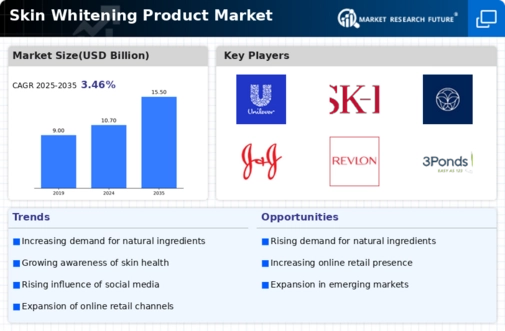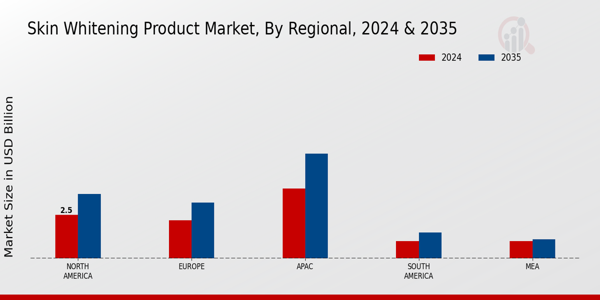Market Growth Projections
The Global Skin Whitening Product Market Industry is projected to experience substantial growth in the coming years. With a market value of 10.7 USD Billion in 2024, the industry is expected to expand at a compound annual growth rate of 3.45% from 2025 to 2035. This growth trajectory suggests a sustained interest in skin whitening products, driven by various factors such as consumer awareness, technological advancements, and emerging market demand. The anticipated market value of 15.5 USD Billion by 2035 underscores the potential for brands to innovate and capture a larger share of this evolving market.
Rising Awareness of Skin Health
The Global Skin Whitening Product Market Industry is experiencing growth due to increasing awareness regarding skin health and aesthetics. Consumers are becoming more informed about the benefits of skin whitening products, which are perceived to enhance beauty and self-esteem. This trend is particularly evident in regions with diverse skin tones, where individuals seek products that promote an even skin tone. As of 2024, the market is projected to reach 10.7 USD Billion, reflecting a growing consumer base that prioritizes skin care. The demand for products that offer both cosmetic and therapeutic benefits is likely to drive further expansion in this sector.
Growing Demand in Emerging Markets
Emerging markets are becoming increasingly important for the Global Skin Whitening Product Market Industry. As disposable incomes rise and urbanization accelerates, consumers in these regions are seeking products that enhance their appearance. The growing middle class in countries such as India and Brazil is driving demand for skin whitening products, which are often associated with social status and beauty ideals. This trend is expected to contribute to the market's growth, with projections indicating a potential increase to 15.5 USD Billion by 2035. The expansion into these markets presents opportunities for brands to tailor their offerings to local preferences and cultural nuances.
Regulatory Support and Quality Standards
The Global Skin Whitening Product Market Industry is benefiting from increased regulatory support and the establishment of quality standards. Governments are implementing regulations to ensure product safety and efficacy, which can enhance consumer trust and drive market growth. This regulatory framework is particularly important in regions where the market has faced scrutiny due to safety concerns. As the industry adapts to these standards, it is likely to foster innovation and improve product offerings, thereby attracting more consumers. The positive regulatory environment may also facilitate market expansion as brands seek to comply with these evolving standards.
Technological Advancements in Product Formulation
Innovations in product formulation are contributing to the growth of the Global Skin Whitening Product Market Industry. Advances in dermatological science have led to the development of safer and more effective skin whitening agents, which appeal to health-conscious consumers. The introduction of products that combine skin whitening with additional benefits, such as anti-aging properties, is likely to attract a broader demographic. As the market evolves, the anticipated compound annual growth rate of 3.45% from 2025 to 2035 indicates a sustained interest in innovative solutions that cater to diverse consumer needs and preferences.
Influence of Social Media and Celebrity Endorsements
Social media platforms and celebrity endorsements play a pivotal role in shaping consumer preferences within the Global Skin Whitening Product Market Industry. Influencers and public figures often promote skin whitening products, which can lead to increased visibility and desirability among consumers. This phenomenon is particularly pronounced in regions where beauty standards are heavily influenced by media portrayals. The market's projected growth to 15.5 USD Billion by 2035 suggests that the impact of social media marketing strategies will continue to be a significant driver, as brands leverage these platforms to reach wider audiences and enhance brand loyalty.






















